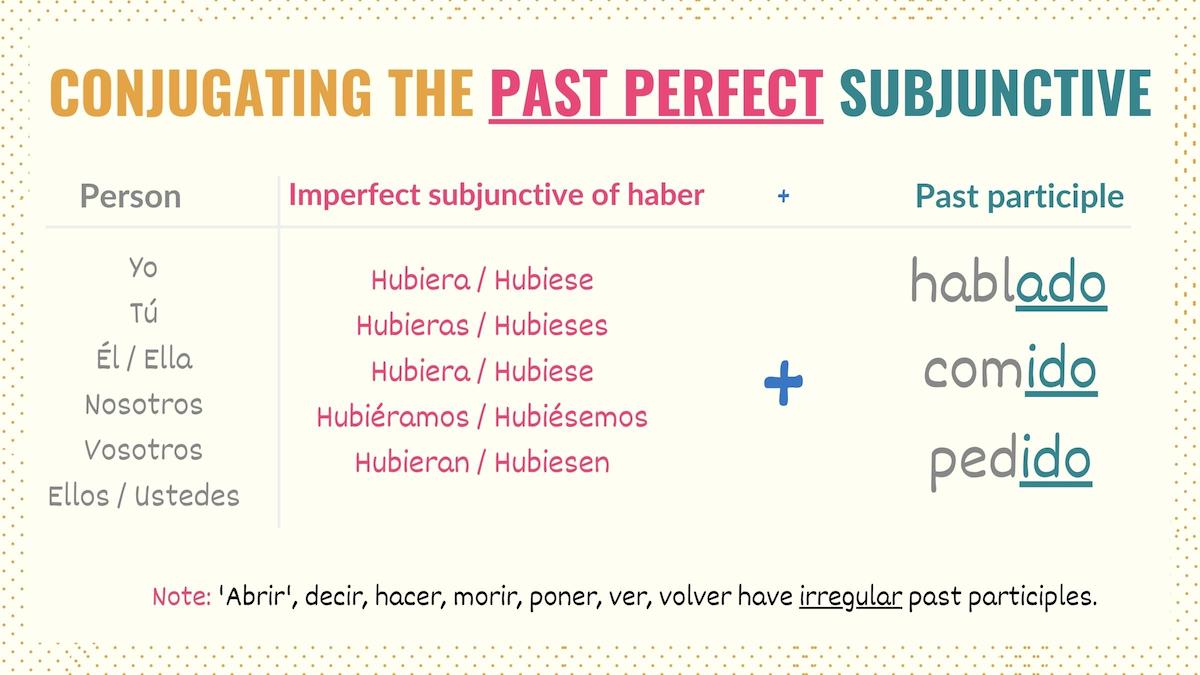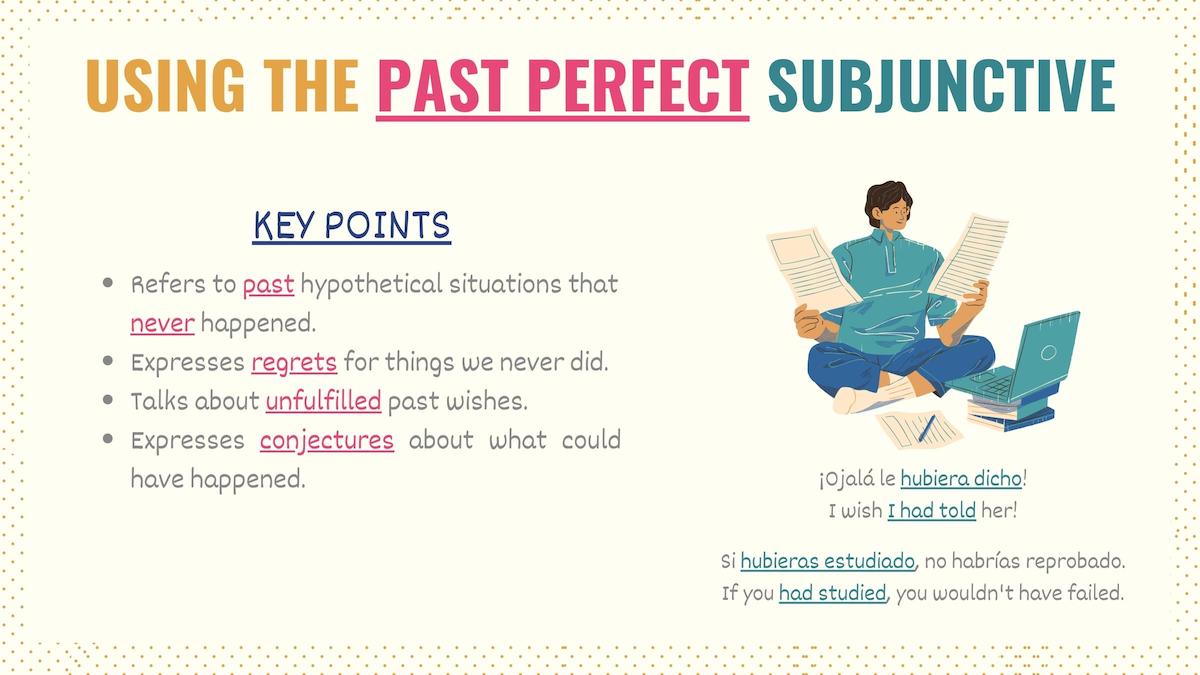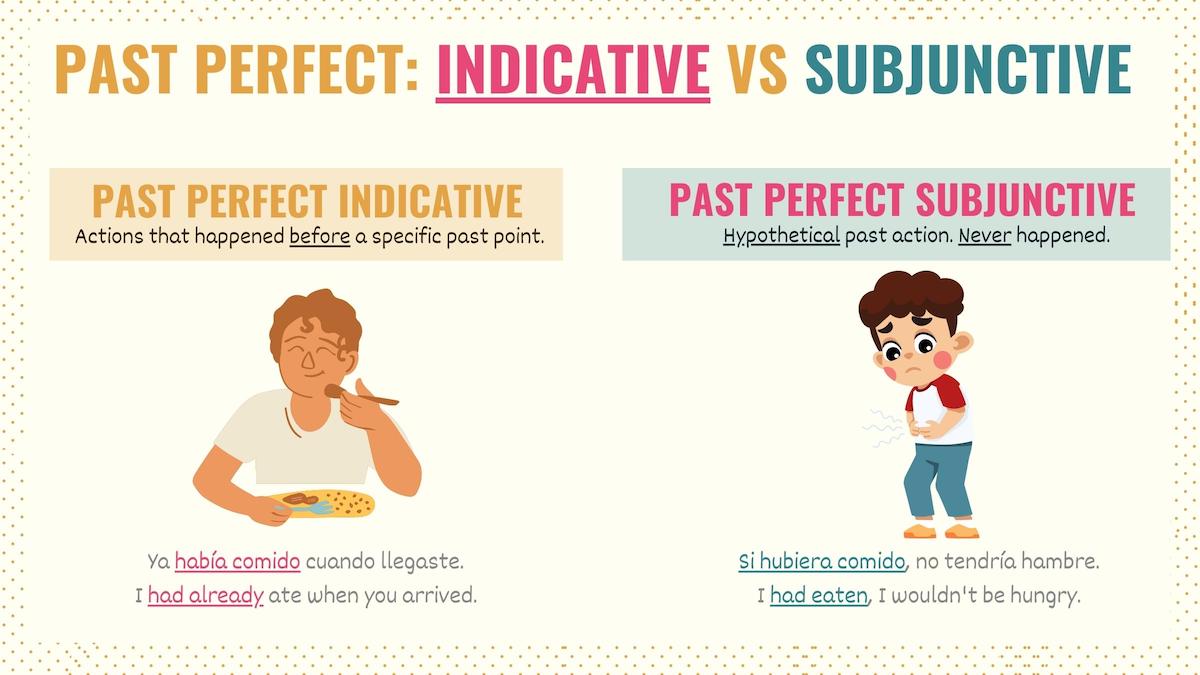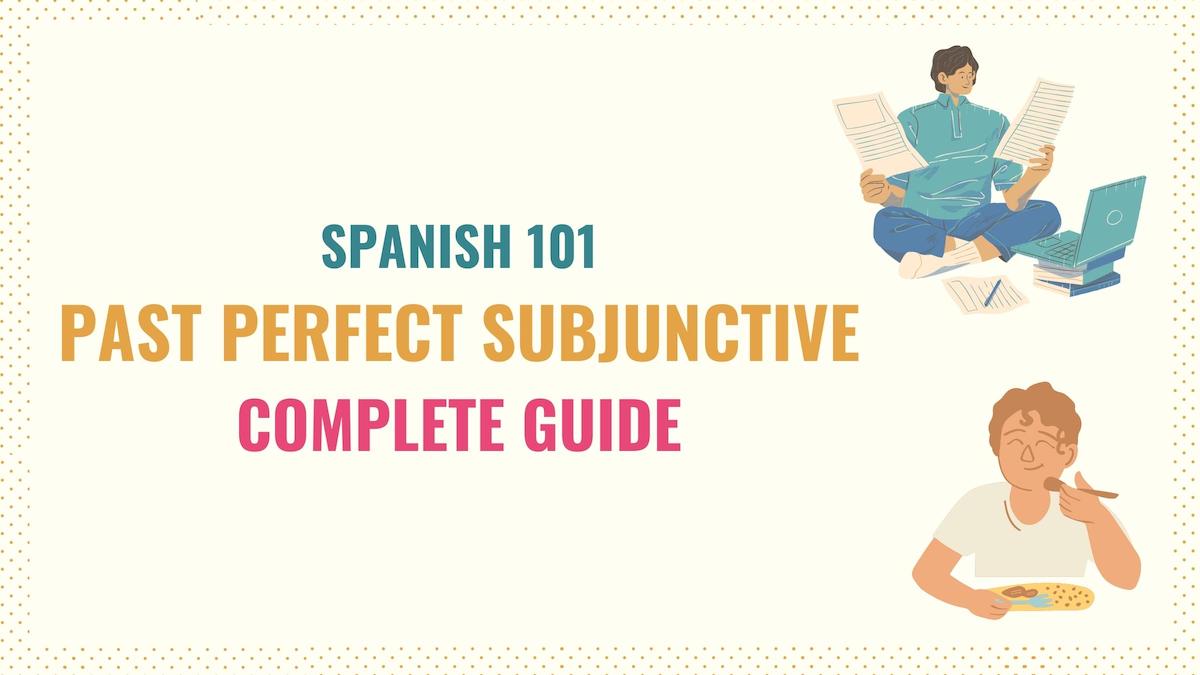Have you ever wished you could have done something differently in the past? Most of us have. In such cases, the past perfect subjunctive Spanish tense (also called pluperfect subjunctive) allows you to talk about hypothetical situations that didn’t happen in the past.
This is one of the most important subjunctive tenses in Spanish since it relates to regrets and the possible results had we taken other actions. As a result, in this guide, you’ll get all the key information to master this tense. Here is an overview of what we’ll cover:
- Conjugating the Spanish Past Perfect Subjunctive
- How & When to Use It
- Past Perfect Indicative vs Pluperfect Subjunctive
- Key Points
- Next Steps & Resources
How to Form the Past Perfect Subjunctive in Spanish
The pluperfect subjunctive Spanish tense is formed by combining the imperfect subjunctive forms of haber and a past participle verb.
As a quick reminder, here are the conjugations of haber that you need to form this tense:
| Person | Imperfect subjunctive form | English equivalent |
|---|---|---|
| Yo | Hubiera / Hubiese | I had |
| Tú | Hubieras / Hubieses | You had |
| Él / Ella Usted | Hubiera / Hubiese | He/She had You had (formal) |
| Nosotros | Hubiéramos / Hubiésemos | We had |
| Ellos / Ellas Ustedes | Hubieran / Hubiesen | They had You had (plural) |
The imperfect subjunctive in Spanish has two endings (-ra, -se). Although they’re interchangeable, the first ending is used in Latin American Spanish and the second in Spain.
Now that you understand how to conjugate the auxiliary verb, let’s check the other formula element.
Regular past participles in Spanish are formed by adding the endings -ado and -ido to the root of -AR and -ER/-IR verbs, respectively. For example, ‘hablar’ becomes hablado and ‘dormir’ becomes dormido.
The irregular verbs in the past perfect subjunctive Spanish tense are those whose past participles are irregular. Some examples of such verbs include:
- Abrir: Abierto
- Decir: Dicho
- Hacer: Hecho
- Morir: Muerto
- Poner: Puesto
- Ver: Visto
- Volver: Vuelto
Here are some sentences putting the formula together:
[Haber in imperfect subjunctive form] + [past participle]
Ojalá hubieras abierto mi regalo.
I wish you would have opened my gift.
Actúan como si no hubieran hecho nada.
They behave as if they had done nothing.
Si hubiera sabido, no le habría dicho nada.
If I had known, I wouldn’t have said anything.

Take Note: The root we use for the imperfect subjunctive forms of haber is heavily based on the preterite conjugation for the third-person plural –ellos hubieron vs ellos hubieran or hubiesen.
How & When to Use the Spanish Past Perfect Subjunctive
Since you already know the elements you need to form the past perfect subjunctive in Spanish, now you’ll learn when and how to use this tense.
The pluperfect subjunctive refers to hypothetical or imaginary situations that never happened. In real-life situations, this tense expresses:
- Past wishes that were never accomplished.
- Regrets about things that never occurred.
- Conjectures about what could have happened.
Let’s see some examples so you can see these applications in context:
¡Ojalá te hubiera dicho lo que siento!
I wish I had told you what I feel!
Si hubiera estudiado, no hubiera reprobado.
If I had studied, I wouldn’t have failed the exam.
¡Me hubieras hablado! Te podría haber acompañado.
You should have called me! I could have gone with you.
All of the previous statements refer to actions that never took place. Take sentence #2 as an example. The test is over, and I failed. At this point, there’s nothing left to do but regret my past actions and imagine what could have happened if I had acted differently.

The Spanish past perfect subjunctive tense can be combined with the following words:
- Aunque: Even though
- Como si: As
- Es posible que: It’s possible that
- Ni que: As if
- No creo que: I don’t think
- Ojalá: I wish / Hopefully / If only
- Si: If
- Tal vez / Quizás: Maybe
Quizás hubiera sido mejor que no dijeras nada.
Maybe it would have been if you didn’t say anything.
Aunque le hubieras dicho, no le habría importado.
Even if you had told her, she wouldn’t have cared.
Spanish past perfect subjunctive + si clauses
Si clauses are one of the most common elements used with the Spanish pluperfect subjunctive. This element introduces the past condition that had to be met for a hypothetical past situation to happen.
Here is the structure you must follow to form these sentences:
Si + [past perfect subjunctive] + [conditional perfect]
¿Qué habrías hecho si te hubieran despedido?
What would you have done if you had been fired?
Si hubiera estado más barato, lo habría comprado.
If it had been cheaper, I would have bought it.
Si te hubieras levantado, habríamos llegado a tiempo.
If you had woken up early, we would have arrived on time.
In Spanish, si clauses can be placed at the beginning or end of the sentence. But notice that when placed first, you must add a comma between the condition and the hypothetical result.
With these types of sentences, the Spanish conditional perfect and the pluperfect subjunctive are interchangeable. In other words, you can use the past perfect subjunctive tense to introduce the condition and the hypothetical result:
Si + [past perfect subjunctive] + [past perfect subjunctive]
Si me hubieras esperado, hubiera ido por ti.
If you had waited for me, I would have picked you up.
Hubiéramos viajado más si hubiéramos tenido más tiempo.
We would have traveled more if we had had more time.
Notice that the hypothetical results in the previous sentences are related to the past (I can no longer pick you up because you’re already here). However, if that result has an impact in the present, you must use the simple conditional:
Si hubiera comido, ahorita no tendría tanta hambre.
If I had eaten, I wouldn’t be so hungry right now.
Bonus: Past Perfect Indicative vs Past Perfect Subjunctive
Because they have the same name and are formed with the same elements (haber + past participle), the past perfect indicative and the past perfect subjunctive can be confused.
As an indicative tense, the past perfect refers to real events that actually happened. This compound tense expresses that an action occurred before a past reference point:
A las diez, ya me había dormido.
By 10, I had already fallen asleep.
On the other hand, the pluperfect subjunctive is used to talk about hypothetical past actions (they never happened). For instance:
Si me hubiera dormido a las 10, no estaría tan cansado.
If I had slept at 10, I wouldn’t be so tired.

Take Note: There is a saying in Spanish that summarizes the past perfect subjunctive. It says “El hubiera no existe” and it implies that regret doesn’t change what we did because we can no longer change it. This expression is close in meaning to “there’s no such thing as what if”.
Key Points
All Spanish subjunctive tenses are crucial for communication. For example, the past perfect subjunctive is crucial to expressing regrets. Here are some key points you should remember:
- The Spanish pluperfect subjunctive refers to past hypothetical scenarios (actions that never happened).
- This tense is conjugated with the imperfect subjunctive forms of haber + past participle verb.
- In real-life situations, the past perfect subjunctive expresses:
- Past regrets and wishes
- Potential results if we had done something different
- Explicit conditions are expressed with si clauses.
- The past perfect subjunctive Spanish tense and the conditional perfect are interchangeable when expressing the hypothetical outcome if a condition had been met.
Past Perfect Subjunctive Spanish Additional Resources
To master this tense, you should know how to conjugate haber and how to form past participles in Spanish. Also, check what the pluperfect indicative in Spanish is, so you can tell the difference between this tense and the pluperfect subjunctive.
Si clauses are a key element to form sentences with the past perfect subjunctive. Click here, to learn when and how to use these structures.
Download the Past Perfect Subjunctive PDF
Now that you’ve learned how and when to use this tense, you probably know you’ll need a refresher on this tense until you’ve fully mastered it. You can download a free PDF copy for this guide with the graphics, uses, conjugations and key points.



